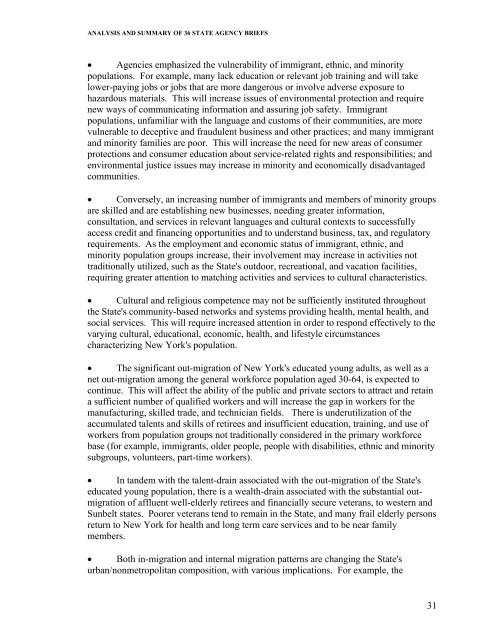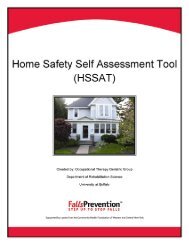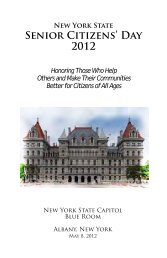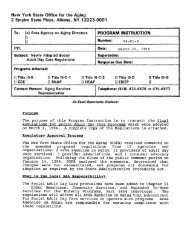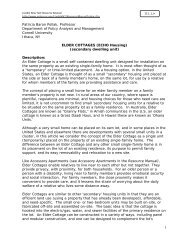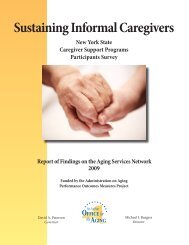White Paper - New York State Office for the Aging
White Paper - New York State Office for the Aging
White Paper - New York State Office for the Aging
- No tags were found...
You also want an ePaper? Increase the reach of your titles
YUMPU automatically turns print PDFs into web optimized ePapers that Google loves.
ANALYSIS AND SUMMARY OF 36 STATE AGENCY BRIEFS<br />
• Agencies emphasized <strong>the</strong> vulnerability of immigrant, ethnic, and minority<br />
populations. For example, many lack education or relevant job training and will take<br />
lower-paying jobs or jobs that are more dangerous or involve adverse exposure to<br />
hazardous materials. This will increase issues of environmental protection and require<br />
new ways of communicating in<strong>for</strong>mation and assuring job safety. Immigrant<br />
populations, unfamiliar with <strong>the</strong> language and customs of <strong>the</strong>ir communities, are more<br />
vulnerable to deceptive and fraudulent business and o<strong>the</strong>r practices; and many immigrant<br />
and minority families are poor. This will increase <strong>the</strong> need <strong>for</strong> new areas of consumer<br />
protections and consumer education about service-related rights and responsibilities; and<br />
environmental justice issues may increase in minority and economically disadvantaged<br />
communities.<br />
• Conversely, an increasing number of immigrants and members of minority groups<br />
are skilled and are establishing new businesses, needing greater in<strong>for</strong>mation,<br />
consultation, and services in relevant languages and cultural contexts to successfully<br />
access credit and financing opportunities and to understand business, tax, and regulatory<br />
requirements. As <strong>the</strong> employment and economic status of immigrant, ethnic, and<br />
minority population groups increase, <strong>the</strong>ir involvement may increase in activities not<br />
traditionally utilized, such as <strong>the</strong> <strong>State</strong>'s outdoor, recreational, and vacation facilities,<br />
requiring greater attention to matching activities and services to cultural characteristics.<br />
• Cultural and religious competence may not be sufficiently instituted throughout<br />
<strong>the</strong> <strong>State</strong>'s community-based networks and systems providing health, mental health, and<br />
social services. This will require increased attention in order to respond effectively to <strong>the</strong><br />
varying cultural, educational, economic, health, and lifestyle circumstances<br />
characterizing <strong>New</strong> <strong>York</strong>'s population.<br />
• The significant out-migration of <strong>New</strong> <strong>York</strong>'s educated young adults, as well as a<br />
net out-migration among <strong>the</strong> general work<strong>for</strong>ce population aged 30-64, is expected to<br />
continue. This will affect <strong>the</strong> ability of <strong>the</strong> public and private sectors to attract and retain<br />
a sufficient number of qualified workers and will increase <strong>the</strong> gap in workers <strong>for</strong> <strong>the</strong><br />
manufacturing, skilled trade, and technician fields. There is underutilization of <strong>the</strong><br />
accumulated talents and skills of retirees and insufficient education, training, and use of<br />
workers from population groups not traditionally considered in <strong>the</strong> primary work<strong>for</strong>ce<br />
base (<strong>for</strong> example, immigrants, older people, people with disabilities, ethnic and minority<br />
subgroups, volunteers, part-time workers).<br />
• In tandem with <strong>the</strong> talent-drain associated with <strong>the</strong> out-migration of <strong>the</strong> <strong>State</strong>'s<br />
educated young population, <strong>the</strong>re is a wealth-drain associated with <strong>the</strong> substantial outmigration<br />
of affluent well-elderly retirees and financially secure veterans, to western and<br />
Sunbelt states. Poorer veterans tend to remain in <strong>the</strong> <strong>State</strong>, and many frail elderly persons<br />
return to <strong>New</strong> <strong>York</strong> <strong>for</strong> health and long term care services and to be near family<br />
members.<br />
• Both in-migration and internal migration patterns are changing <strong>the</strong> <strong>State</strong>'s<br />
urban/nonmetropolitan composition, with various implications. For example, <strong>the</strong><br />
31


